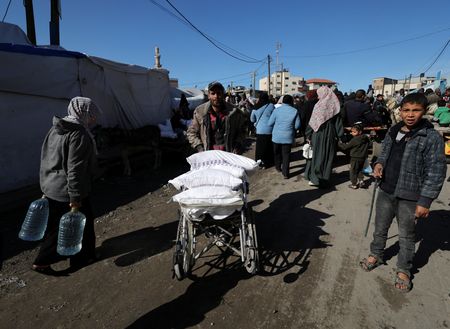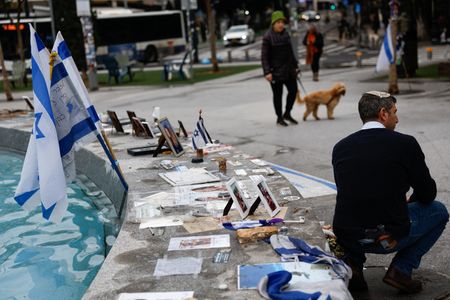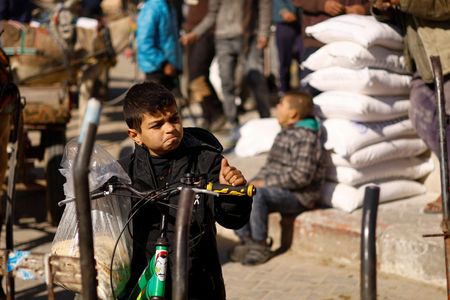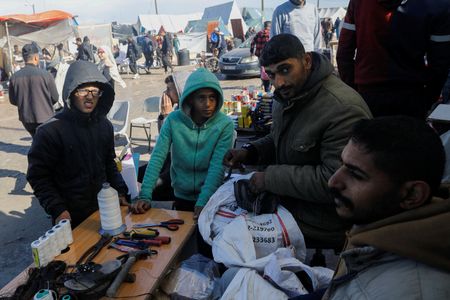WASHINGTON (Reuters) -The planned targets for U.S. strikes in Iraq and Syria in response to the killing of three U.S. soldiers by a drone in Jordan include “Iranian personnel and facilities”, CBS News reported on Thursday, citing American officials.
The United States has assessed that the drone, which also wounded more than 40 people, was made by Iran, four U.S. officials told Reuters. Sources said Iran’s elite Revolutionary Guards were pulling senior officers out of Syria.
The CBS report follows days of conjecture about how Washington would retaliate after three U.S. soldiers were killed on Saturday in a strike on their base.
The fatalities were the first U.S. deaths in an escalation of violence across the Middle East since Israel’s war in Gaza began in October.
Even as fighting has intensified this week, diplomatic efforts to achieve a ceasefire in the Palestinian enclave have accelerated.
Qatari and Egyptian mediators presented Hamas, the militant group that runs Gaza, with the first concrete proposal for an extended halt to fighting, agreed with Israel and the U.S. at talks in Paris last week.
A Palestinian official close to the negotiations told Reuters the text envisages a first phase of 40 days, during which fighting would cease while Hamas freed remaining civilians among the more than 100 hostages it still holds. Further phases would see the handover of Israeli soldiers and bodies of dead hostages.
Such a long pause would be a first since Oct. 7, when Hamas fighters attacked Israel, killing 1,200 people and capturing 253 hostages, precipitating an Israeli offensive that has laid waste to much of Gaza.
Health officials in the enclave said on Thursday the confirmed Palestinian death toll had risen above 27,000, with thousands more dead still lying under the rubble.
A Palestinian official said Hamas was unlikely to reject the proposal outright, but would demand guarantees that fighting would not resume, something Israel has not agreed to.
REPORTS OF CEASEFIRE DEAL ARE DENIED
A positive-sounding speech by a Qatari spokesman at Johns Hopkins University in Washington briefly triggered some celebrations in Gaza – and a drop in the price of crude oil.
But a Qatari official in Doha told Reuters there was no ceasefire deal yet, and that Hamas had “received the proposal positively” but not responded yet.
And Taher Al-Nono, media adviser to Hamas chief Ismail Haniyeh, told Reuters: “We have received the proposal that was put together in Paris but we haven’t yet given a response to any of the parties.”
“We can’t say that the current stage of negotiation is zero and at the same time we can’t say that we have reached an agreement.”
Celebratory firing into the air and cheering in central and southern Gaza were soon suppressed by an air strike on a house in Gaza’s main southern city, Khan Younis, that wounded 13 people, according to hospital officials.
Israel started a huge ground assault last week to capture Khan Younis, and combat has also surged in northern areas that Israel claimed to have subdued weeks ago.
Defence Minister Yoav Gallant said Israeli forces had now dismantled the Hamas brigade in Khan Younis, and that they had killed 10,000 Palestinian fighters and wounded the same number again since the war began nearly four months ago.
He said those forces would now press on to Rafah on the enclave’s southern edge, where more than half of Gaza’s 2.3 million people are sheltering, mainly cold and hungry in makeshift tents and public buildings.
Residents said Israeli forces had pounded areas around hospitals in Khan Younis overnight, and stepped up attacks close to Rafah.
Osama Ahmed, 49, a father of five from Gaza City now sheltering in western Khan Younis, said there had been fierce resistance in the city, and relentless bombardment from air, ground and sea as Israeli tanks advanced.
“They haven’t entered deep into Al-Mawasi where we live but every day they get closer,” he told Reuters by phone. “All we want is a ceasefire now.”
U.S. PUTS PRESSURE ON ISRAEL
Appeals to Israel from its main ally, the United States, show little sign of having succeeded in easing the plight of Gaza’s civilians.
Washington is stepping up indirect pressure, however.
U.S. President Joe Biden issued an executive order that aims to punish Jewish settlers who attack Palestinians in the occupied West Bank in an surge of violence triggered by the war in Gaza.
Biden is also under pressure to respond firmly to the killing of U.S. soldiers – which Washington says bears the “footprints” of Kataib Hezbollah, a pro-Iranian militia based in neighbouring Iraq – without igniting a wider war with Iran.
That group said on Wednesday it was suspending military action against U.S. forces to avoid embarrassing Baghdad.
Iran’s Revolutionary Guards, who have lost more than half a dozen of their members to Israeli strikes since December, are pulling their senior officers out of Syria, sources familiar with the matter told Reuters. Iranian advisers assist armed groups in both Iraq, where the U.S. has around 2,500 troops, and Syria, where it has 900.
The CBS report quoted U.S. officials as saying weather would be a factor in the timing of the retaliatory U.S. strikes as Washington preferred good visibility to guard against the risk of hitting civilians.
Further afield, the Iran-aligned Houthi movement, which controls the most populous parts of Yemen, has attacked shipping in the Red Sea in what it says is solidarity with Gaza, drawing retaliatory strikes from the United States and Britain.
Overnight, the U.S. military said it had hit up to 10 drones in Yemen being prepared for launch, while a U.S. Navy ship downed three Iranian-made drones and a Houthi anti-ship missile.
Two anti-ship ballistic missiles fired from Houthi-controlled areas in Yemen hit the water rather than their likely target, the Liberian-flagged, Bermuda-owned freighter M/V KOI, U.S. Central Command said.
(Reporting by Nidal al-Mughrabi in Doha, Paul Grant in Washington, Tala Ramadan and Jana Choukeir in Dubai, Ari Rabinovitch in Jerusalem; Writing by Peter Graff and Kevin Liffey; Editing by Angus MacSwan)





